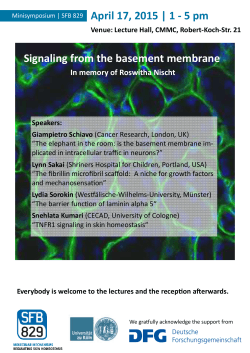
#14960 - Cell Signaling Technology
Store at -20ºC #14960 EphB4 (D1C7N) Rabbit mAb www.cellsignal.com Support: 877-678-TECH (8324) www.cellsignal.com/support 100 µl (10 western blots) Orders: 877-616-CELL (2355) orders@cellsignal.com New 04/15 Entrez-Gene ID #2050 UniProt ID #P54760 For Research Use Only. Not For Use In Diagnostic Procedures. Applications W, IP, IHC-P, IF-IC Endogenous Species Cross-Reactivity* Molecular Wt. Isotype H 135 kDa Rabbit IgG** Storage: Supplied in 10 mM sodium HEPES (pH 7.5), 150 mM NaCl, 100 µg/ml BSA, 50% glycerol and less than 0.02% sodium azide. Store at –20°C. Do not aliquot the antibody. *Species cross-reactivity is determined by western blot. The ephrin receptor B4 (EphB4) is normally expressed on venous endothelial cells, while arterial endothelial cells express its ligand, EphrinB2. Together, EphB4 and EphrinB2 play an important roll in vasculature development and maintenance (8). Research studies show that various cancers, including breast, colorectal, esophageal, and pancreatic cancers, express EphB4 (9-12). However, as EphB4 has been shown to have both tumor suppressive and promoting properties, its role in tumorigenesis and tumor progression remains uncertain (13). kDa 200 140 100 80 **Anti-rabbit secondary antibodies must be used to detect this antibody. HT -2 9 M CF 7 A20 4 78 6O Background: The Eph receptors are the largest known family of receptor tyrosine kinases (RTKs). They can be divided into two groups based on sequence similarity and on their preference for a subset of ligands: EphA receptors bind to a glycosylphosphatidylinositol-anchored ephrin A ligand; EphB receptors bind to ephrin B proteins that have a transmembrane and cytoplasmic domain (1,2). Research studies have shown that Eph receptors and ligands may be involved in many diseases including cancer (3). Both ephrin A and B ligands have dual functions. As RTK ligands, ephrins stimulate the kinase activity of Eph receptors and activate signaling pathways in receptor-expressing cells. The ephrin extracellular domain is sufficient for this function as long as it is clustered (4). The second function of ephrins has been described as “reverse signaling”, whereby the cytoplasmic domain becomes tyrosine phosphorylated, allowing interactions with other proteins that may activate signaling pathways in the ligand-expressing cells (5). Various stimuli can induce tyrosine phosphorylation of ephrin B, including binding to EphB receptors, activation of Src kinase, and stimulation by PDGF and FGF (6). Tyr324 and Tyr327 have been identified as major phosphorylation sites of ephrin B1 in vivo (7). EphB4 60 50 40 30 20 For product specific protocols and a complete listing of recommended companion products please see the product web page at www.cellsignal.com 10 50 40 Recommended Antibody Dilutions: Western blotting 1:1000 Immunoprecipitation1:50 Immunohistochemistry (Paraffin) 1:500† Unmasking buffer: Citrate Antibody diluent: SignalStain® Antibody Diluent #8112 Detection reagent: SignalStain® Boost (HRP, Rabbit) #8114 †Optimal IHC dilutions determined using SignalStain® Boost IHC Detection Reagent. Immunofluorescence (IF-IC)1:800 IF Protocol: Methanol Fixation required β-Actin Western blot analysis of extracts from various cell lines using EphB4 (D1C7N) Rabbit mAb (upper) and β-Actin (D6A8) #8457 (lower). Background References: (1) Wilkinson, D.G. (2000) Int Rev Cytol 196, 177-244. (2) Klein, R. (2001) Curr Opin Cell Biol 13, 196-203. (3) Dodelet, V.C. and Pasquale, E.B. (2000) Oncogene 19, 5614-9. (4) Holder, N. and Klein, R. (1999) Development 126, 2033-44. (5) Brückner, K. et al. (1997) Science 275, 1640-3. (6) Palmer, A. et al. (2002) Mol Cell 9, 725-37. (7) Kalo, M.S. et al. (2001) J Biol Chem 276, 38940-8. (8) Wang, H.U. et al. (1998) Cell 93, 741-53. (9) Kumar, S.R. et al. (2006) Am J Pathol 169, 279-93. Specificity/Sensitivity: EphB4 (D1C7N) Rabbit mAb recognizes endogenous levels of total EphB4 protein. (10) D avalos, V. et al. (2006) Cancer Res 66, 8943-8. (11) H asina, R. et al. (2013) Cancer Res 73, 184-94. Source/Purification: Monoclonal antibody is produced by immunizing animals with recombinant protein specific to the amino terminus of human EphB4 protein. (12) L i, M. and Zhao, Z. (2013) Mol Biol Rep 40, 1735-41. Immunohistochemical analysis of paraffin-embedded human colon carcinoma using EphB4 (D1C7N) Rabbit mAb, showing staining of endothelial cells. (13) N oren, N.K. and Pasquale, E.B. (2007) Cancer Res 67, 3994-7. DRAQ5 is a registered trademark of Biostatus Limited. Tween is a registered trademark of ICI Americas, Inc. IMPORTANT: For western blots, incubate membrane with diluted antibody in 5% w/v BSA, 1X TBS, 0.1% Tween®20 at 4°C with gentle shaking, overnight. Thank you for your recent purchase. If you would like to provide a review visit www.cellsignal.com/comments. ©2015 Cell Signaling Technology, Inc. SignalStain and Cell Signaling Technology are trademarks of Cell Signaling Technology, Inc. Applications: W—Western IP—Immunoprecipitation IHC—Immunohistochemistry ChIP—Chromatin Immunoprecipitation IF—Immunofluorescence F—Flow cytometry E-P—ELISA-Peptide Species Cross-Reactivity: H—human M—mouse R—rat Hm—hamster Mk—monkey Mi—mink C—chicken Dm—D. melanogaster X—Xenopus Z—zebrafish B—bovine Dg—dog Pg—pig Sc—S. cerevisiae Ce—C. elegans Hr—Horse All—all species expected Species enclosed in parentheses are predicted to react based on 100% homology. Immunohistochemical analysis of paraffin-embedded human breast carcinoma using EphB4 (D1C7N) Rabbit mAb. Immunohistochemical analysis of paraffin-embedded MCF7 (left) and 786-O (right) cell pellets using EphB4 (D1C7N) Rabbit mAb. HT-29 Immunohistochemical analysis of paraffin-embedded human placenta using EphB4 (D1C7N) Rabbit mAb. Confocal immunofluorescent analysis of HT-29 (left) and 768-O (right) cells using EphB4 (D1C7N) Rabbit mAb (green). Blue pseudocolor = DRAQ5® #4084 (fluorescent DNA dye). Orders: 877-616-CELL (2355) | orders@cellsignal.com | Support: 877-678-TECH (8324) | info@cellsignal.com © 2015 Cell Signaling Technology, Inc. 768-O
© Copyright 2025





















